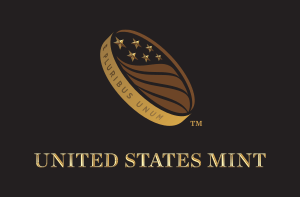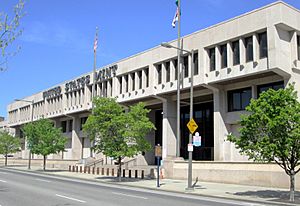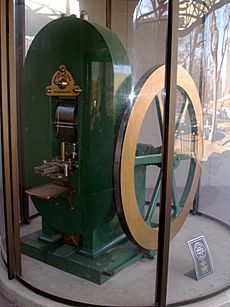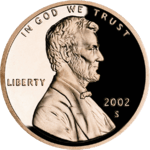United States Mint facts for kids

Seal of the U.S. Mint
|
|

Logo of the U.S. Mint
|
|
| Agency overview | |
|---|---|
| Formed | April 2, 1792 |
| Jurisdiction | Federal government of the United States |
| Headquarters | Washington, D.C., U.S. |
| Employees | 1,845 (2006) |
| Agency executive |
|
| Parent agency | Department of the Treasury |
The United States Mint is a special agency that makes all the coins for the United States. These coins are used for buying, selling, and trading. The Mint also handles valuable metals like gold and silver. It's important to know that the Mint does not print paper money. That job belongs to another agency called the Bureau of Engraving and Printing.
The first Mint was started in Philadelphia in 1792. Soon, other places also began making coins. Each of these places had its own special mark on the coins. Today, there are four main places where U.S. coins are made: Philadelphia, Denver, San Francisco, and West Point.
Contents
History of the U.S. Mint
The U.S. Mint was created by the U.S. Congress in 1792. This happened with a law called the Coinage Act of 1792. At first, the Mint was part of the Department of State. The very first Mint building was in Philadelphia, which was the capital city at that time. It was the first building the U.S. government built under the U.S. Constitution.
Today, the main office of the Mint is in Washington, D.C.. This office doesn't make coins. The Mint has coin-making factories in Philadelphia, Denver, San Francisco, and West Point, New York. It also has a special storage place for gold called a bullion depository at Fort Knox, Kentucky. In the past, there were also Mints in other cities like Carson City, Nevada, New Orleans, Louisiana, and even Manila in the Philippines.
In 1799, the Mint became its own independent agency. It used to turn valuable metals into coins for anyone, without extra fees. Later, in 1873, the Mint became part of the Department of the Treasury. Since 1981, it has been overseen by the Treasurer of the United States. Today, all U.S. coins are made for the Treasury.
Where Are U.S. Coins Made?
There are four active places where the U.S. Mint makes coins. These are in Philadelphia, Denver, San Francisco, and West Point.
Philadelphia Mint: The Main Coin Factory
The Philadelphia Mint is the biggest coin-making factory. The current building in Philadelphia opened in 1969. It is the fourth Mint building in that city. The first one started in 1793. Until 1980, coins made in Philadelphia usually didn't have a special mark. The only exceptions were the Susan B. Anthony dollar and some Jefferson nickels made during wartime. In 1980, the letter "P" was added to most U.S. coins made in Philadelphia. The only coin that still doesn't have a "P" mark is the cent (penny).
The Philadelphia Mint also creates the original designs and tools (called dies) for all U.S. coins. The artists and designers who create coin images work here too.
Denver Mint: Coins from the Gold Rush
The Denver branch started in 1863. It was first a place to test gold and silver. This was just five years after gold was found in the area. By 1906, the Mint opened its new building in Denver. Coins made in Denver have a "D" mint mark. This Mint mostly makes coins for everyday use. It also makes the tools (dies) that other Mints use to stamp coins.
San Francisco Mint: Serving the Gold Rush
The San Francisco branch opened in 1854. It was built to help with all the gold found during the California Gold Rush. Coins from San Francisco have an "S" mint mark. The first building quickly became too small. A new one opened in 1874. This building was one of the few that survived the big earthquake and fire in 1906.
The San Francisco Mint closed in 1955 but reopened ten years later. This was because there weren't enough coins in the mid-1960s. Since 1975, this Mint has mostly made special "proof" coins for collectors.
West Point Mint: The Newest Coin Factory
The West Point branch is the newest official Mint. It became a branch Mint in 1988. Before that, it was a place to store gold, opened in 1937. Pennies were made here from 1973 to 1986. These pennies looked exactly like those made in Philadelphia.
West Point has made many special collector coins and "proof" coins. These coins have a "W" mint mark. In 1996, West Point made some dimes, but only for collectors, not for everyday use. The West Point facility still stores some of the United States' gold bullion (gold bars). It is also where gold, silver, and platinum American Eagle coins are made.
Fort Knox: Where Gold is Stored
The U.S. Bullion Depository at Fort Knox, Kentucky, is another important Mint facility. It doesn't make coins. Its main job is to keep the gold and silver reserves safe for the United States and other countries.
What Does the U.S. Mint Do?
The U.S. Mint does many important things. It has programs to sell special coins to collectors. Its products include:
- Making coins for everyday use, for collectors, and for other countries.
- Creating and selling national medals.
- Designing and making Congressional Gold Medals. These are high honors given by Congress.
- Designing, making, and selling special collector coins.
- Keeping gold and silver safe and tracking its movement.
- Giving out gold and silver for approved reasons.
- Sending coins from the different Mints to Federal Reserve Banks.
Remember, the Mint does not make paper money. That is the job of the Bureau of Engraving and Printing. In the year 2000, the Mint made 28 billion coins! The United States Mint Police is a special police force. They protect the Mint buildings, its workers, and the valuable metals stored there.
Understanding Coin Mintmarks
A mintmark is a small letter on a coin. It tells you which Mint facility made the coin. Before 1909, most coins from branch Mints had their mintmark on the back (reverse) side. For a short time in 1838 and 1839, some gold and silver coins had their mintmarks on the front (obverse) side. The Carson City Mint used a "CC" mintmark. The Manila Mint in the Philippines used an "M" mintmark from 1920 to 1941.
Between 1965 and 1967, mintmarks were temporarily removed from coins. This was done to stop people from collecting coins. In 1968, mintmarks were moved to the front (obverse) side of the nickel, dime, quarter, and half dollar. They have been on the front of the dollar coin since 1971.
Here's where to find the mintmark on different U.S. coins:
- Penny: The mintmark is on the front, below the date, to the right of Abraham Lincoln's head. This has been true since 1909.
- Nickel: From 1968 to 2005, the mintmark was near the edge on the front, to the right of Thomas Jefferson's head. On newer nickels (since 2006), it's below the date on the lower right. Older nickels (1938-1964) have the mintmark on the back, to the right of Monticello.
- Dime: The mintmark is on the front, above the date, to the right of Franklin D. Roosevelt's head.
- Quarter dollar: The mintmark is on the front, to the right of George Washington's head.
- Half dollar: The mintmark is on the front, below the center of John F. Kennedy's head, above the date.
- Eisenhower Dollar (1971–1978): The mintmark is on the front, below the center of Dwight D. Eisenhower's head, above the date.
- Susan B. Anthony dollar (1979–1981, 1999): The mintmark is on the front, to the left of Susan B. Anthony's head.
- Sacagawea dollar (2000–2016): For coins made from 2000 to 2008, the mintmark is just below the date. For coins made from 2009 to 2016, the date and mintmark are on the edge of the coin.
- Presidential dollar (2007–2016): The mintmark and date are found on the edge of the coin.
During World War II, there was a shortage of nickel. So, the five-cent coin (nickel) was made with some silver. To show this change, nickels made in Philadelphia (which usually had no mintmark) got a "P" mark. This "P" was placed above the dome of Monticello on the back of the coin. Nickels from San Francisco and Denver also showed this change. This new mintmark spot lasted until 1946, when the nickel went back to its old metal mix.
The "P" mintmark disappeared after the war. It came back in 1979 on the Anthony dollar. By 1982, it was on almost every regular coin, except the penny. For 2017, the "P" mintmark was placed on Philadelphia-made Lincoln pennies for the first time. This was to celebrate the Mint's 225th Anniversary. However, the "P" mintmark will not be on pennies made in Philadelphia for 2018 and beyond.
 In Spanish: Casa de Moneda de los Estados Unidos para niños
In Spanish: Casa de Moneda de los Estados Unidos para niños







